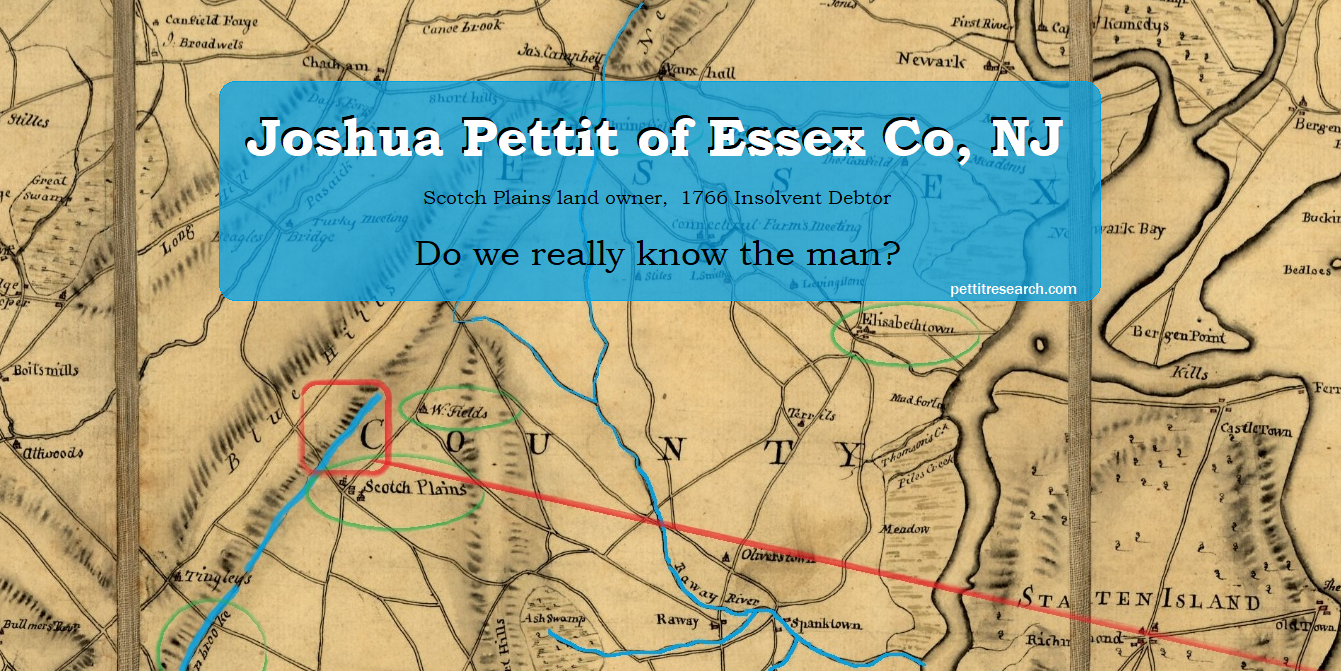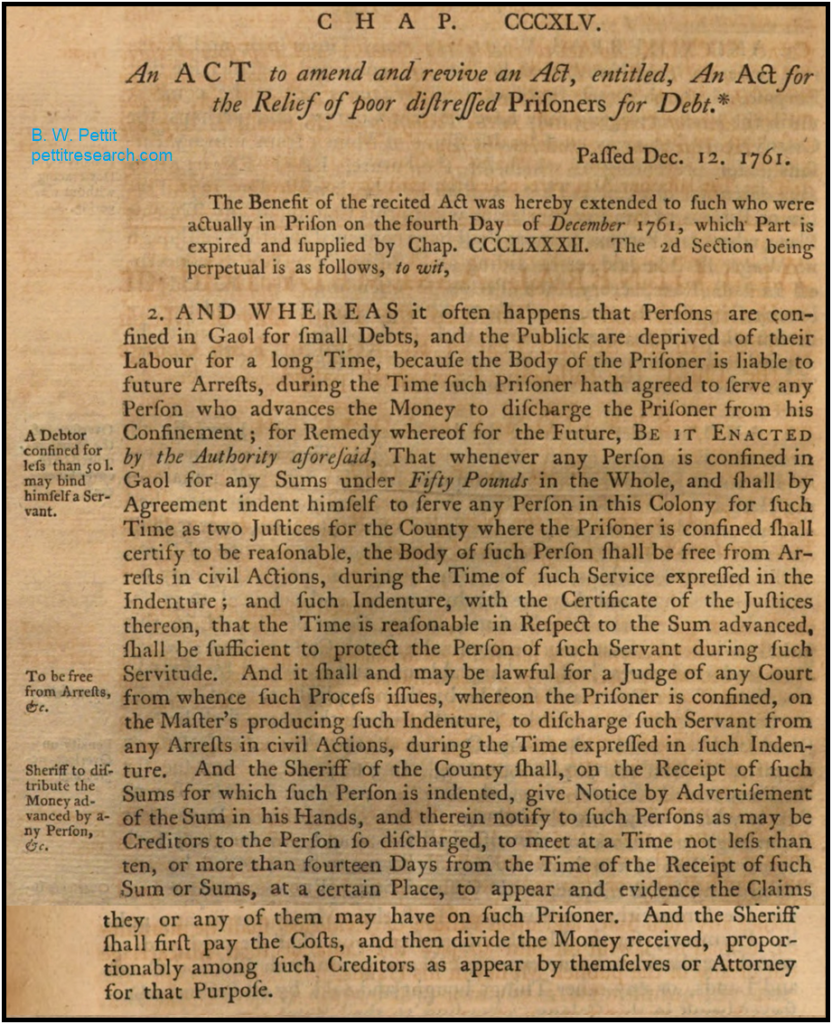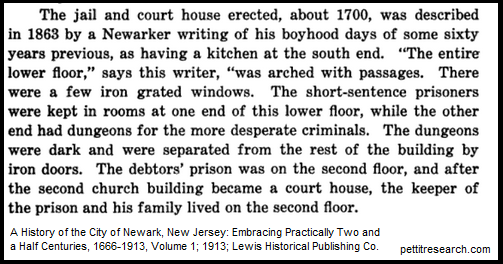Joshua Pettit of Essex Co., NJ: The Insolvent Debtor (Part II)

The Insolvent Debtor
Have you heard the theory that Joshua Pettit of Spartanburg County, SC was the Joshua Pettit of Essex County, New Jersey who was an insolvent debtor? This article will cover the results of legal research of the insolvent debtor laws of the province of New Jersey from 1761-1766 and how they applied to Joshua Pettit. An effort has been made to present the details of the law in a comprehensive manner to remove any doubt about the final, somewhat controversial, conclusion. The location of Joshua Pettit during these years may come as a surprise.
In the 1760’s, public notices appeared in newspapers on behalf of various insolvent debtors in the colony of New Jersey. One of these was the January 23, 1766, notice for Joshua Pettit of Essex Co., NJ which was published in the New York Post Boy as seen below:
1766, January 23
Essex County, )
New-Jersey ) Pursuant to an Order of Daniel Pearson, and Jonathan Hampton, Esquires, Two of the Judges of the Court of Common Pleas for the County of Essex, upon the Petition of Joshua Petit, an insolvent Debtor, and the Majority of his Creditors, Notice is hereby given to all the Creditors of said Joshua Petit, to shew Cause, (if any they have) before the said Judges, on Monday the Tenth of February next, at 9 o’Clock of the said Day, at the House of Mrs. Johnston Innkeeper in Elizabeth-Town, why any Assignment of the Estate of said Joshua Petit should not be made according to the Prayer of the said Petition to such Persons as shall be appointed, and the said Debtor discharged, pursuant to an Act of Assembly, made this present year, entitled, ‘An Act for the Relief of insolvent Debtors.’ Dated January the 15th, 1766.– [Source: The New York Gazette or Weekly Post Boy, No. 1204, January 23, 1766.]
This was followed over a year later by a notice issued on August 6, 1767, in the New York Journal which stated:
This is to Notify the Creditors of Joshua PETTIT, an insolvent debtor, to meet at the House of Mr. Jonathan Osborne, at the Scotch-Plains, in the Borough of Elizabeth, East New- Jersey, on Thursday the 20th of August, Instant; when and where, the Assignees of said PETTIT, will attend to settle with said Creditors. Scotch-Plains, Borough of Elizabeth, East N. Jersey.” – [Source: The New York Journal or General Advertiser, No. 1283, August 6, 1767.]
Other notices with similar language were placed around the same time for other unrelated individuals. These notices were not the handy work of a colonial bankruptcy attorney or debt consolidation firm. Nor was there any other paid person working on behalf of the debtors. They could not pay for such services because they were, after all, insolvent debtors.
These similarly worded notices were simply constructed by court officials and sheriffs to comply with what was required by law. To be specific, they were required by “An Act for the Relief of Insolvent Debtors.”
It should be noted that the original notice that ran on January 23, 1766, was pursuant to an order of Daniel Pearson, and Jonathan Hampton. These men were Judges of the Court of Common Pleas. Their court minute books reveal that during the years in question (1765-1767) they held court in Essex County and served the community with an open court in Newark as well as the Borough of Elizabeth. The books record petitions and suits brought forward by free people residing in the county. A thorough review of the records of the regular sessions of the Common Pleas turned up no mention of a petition by Joshua Pettit, nor any of the other insolvent debtors of the county. To get a better understanding of why this was, we turn to the text of the law itself.
An Act for the Relief of Insolvent Debtors
An act entitled “An Act for the Relief of Insolvent Debtors” was passed by the New Jersey Assembly on June 18, 1765. The act of 1765 extended a prior act from 1763 which was an extension of yet another act passed on December 12, 1761. The text of that act which was essentially the same act as the one Joshua Pettit sought relief under is shown below:

Acts of the Province of New Jersey From the Surrender of the Government to Queen Anee on the 17th Day of April, in the Year of Our Lord 1702, to the 14th Day of January 1776. Compiled and published by Samuel Allinson under the appointment of the General Assembly, pp 244-245.
The act begins with, “Whereas it often happens that persons are confined in gaol [jail] for small debts…” This act was for the express purpose of providing some aid to debtors who had been confined to the county jail or “gaol” as punishment for their unpaid debts. The extensions in ’63 and ’65 further limited the scope to apply exclusively to those in jail. So-called debtor’s prisons in England as well as some colonies were institutions known for notoriously trapping debtors into a horrible form of perpetual servitude. With a single unexpected turn of events anyone could fall victim to such a fate. Life itself for most colonists was dependent on good weather, good health, and good fortune. The New Jersey Assembly was well ahead of its time by compassionately providing relief to those who were imprisoned for debt and allowed them a way to literally work themselves back into society.
As stated in the text of the 1761 act above and affirmed in the extended acts of 1763 and 1765, the law only applied to those insolvent debtors who were confined to the jail for their debts. Here is a summary of the law:
- Applied only to persons imprisoned for debt below 50lbs (roughly $15,000.00 in today’s money)
- If the person shall indent himself to serve any person in the colony for such time as two justices for the county where person is confined shall certify to be reasonable…
- The person himself shall be free from consideration as a human asset in civil action (can’t be further indentured or jailed while indentured under this act.)
- When the master of the debtor produces the proof of indenture to a judge of any court where the person is jailed, the judge can discharge the servant to be free from arrest for his debts. (but not free to go)
- The sheriff will receive the sums of money the person earns while indentured. The debtor receives nothing.
- When the sheriff receives an adequate some of money for the person’s indented servitude, the sheriff shall “give notice by advertisement of the sum in his hands and therein notify to such person as may be creditors to the person… to meet at a time not less than ten or more than fourteen days from the time of the receipt of such sum“.
- This meant the amount of debt had to be determined ahead of time and the person was not supposed to be indentured beyond the time it took to pay the debt they owed.
- When the money was raised, the sheriff was to first take payment for his services and then divide the remaining money proportionally among the creditors.
- After this, the insolvent debtor was free of his indenture and released from jail.
When put into practice, the process is elsewhere summarized for legal purposes as such:
The petition to the court by prisoner for hearing:
- Imprisoned person makes petition for discharge
- Time set for hearing and notice given (See first notice issued for Joshua Pettit above)
- Proceeding at the hearing
- Examination of debtor
- Further examination
- Assignment and assignee, and discharge of debtor
- Or discharge of same after term of imprisonment expired
The Estate/ Power of Assignees
- Estate vested in assignee; to divide proceeds
- What conveyances by debtor void
- Assignee’s power to sell
- Notice to be given by assignee for meeting of creditors (See second notice issued for Joshua Pettit above)
- Oath and accounts of assignee
- Proceedings to discover effects of debtor
- May examine wife of debtor
- When suit in equity
- Bail may come in as a creditor
- The debtor is discharged
Joshua Pettit -Slave to Debt
For this Joshua Pettit to make a petition to the Essex County Court of Common Pleas under the law, he obviously had to meet the requirements of the law as an insolvent debtor. The law is quite clear in who it applied to. It applied only to persons currently in jail for their debts. The reason Joshua Pettit’s petition cannot be found in the record books of the regular Court of Common Pleas is because he was not a free man. He was most likely in the Newark jail in Essex County for the “crime” of being an insolvent debtor. The Newark debtors jail was built around 1700 and one floor was reserved for insolvent debtors. It is described in the book “A History of the City of Newark, New Jersey” by Lewis Historical Publishing Co. as follows:

A History of the City of Newark, New Jersey: Embracing Practically Two and a Half Centuries, 1666-1913, Volume 1; 1913; Lewis Historical Publishing Co.
Joshua’s petition probably would have been handled by a Special Court of Common Pleas, not the regular court, and that is why there is no record in the minutes of the regular Court of Common Pleas.
A different NJ county archives (Monmouth) explained the insolvent debtor laws like this:
Insolvent Debtor records are cases of the Special Court of Common Pleas, held for the purpose of hearing applications of imprisoned debtors for discharge; and case files, consisting of loose papers used in Common Pleas proceedings, containing petitions of debtors, lists of debts, interrogatories put to the petitioner, discharges from confinement, and joint petitions and discharge lists, documenting 2,039 insolvent debtor cases in Monmouth County.
It has yet to be determined where the records of the Special Court for Essex County may be located. Other county archives appear to have a separate record book for colonial cases of insolvent debtors. This researcher has not searched these records in Essex Co. as they can can only be viewed in person. The records may contain the details of Joshua Pettit’s insolvency hearing, an inventory of his estate, and a list of people he owed money to. All of this would be of immense genealogical value. (If anyone is interested in searching these onsite in New Jersey, contact me, for details!)
With the information we do have, this matter can be concluded as follows: It can be said with relative confidence that sometime before January of 1766, Joshua Pettit was confined to a jail in Essex County, NJ for his debts. Here he applied for relief under the Act. He was possibly indentured to someone for a period of time to work off his debt. While doing this, the remainder of his estate would have been sold and money deposited with the Sheriff. As was the case with most other insolvent debtors, he was allowed to work but had to return to the jail each day as a prisoner. He most likely remained in jail until after his assignee and creditors met on August 20, 1767 in Scotch Plains, NJ. After this, his debts would have been satisfied and he would have been discharged from his servitude and from jail.
The law did allow for bail and some prisoners were granted free movement within a mile or so of the jail. Judging by the time between the two mandatory legal notices put out in the newspapers quoted above and the fact that they were both required at different temporal ends of the process by law, it seems very likely that this Joshua Pettit fully complied with the terms of the law. Had he been released, escaped, fled the county or died during this period, the final notice in 1767 would not have happened. The 1767 notice was, in essence, the last public notice before his debts were declared “paid in full.”
He was imprisoned in Essex County at least until the creditors and his assignee met at Jonathan Osborn’s house on August 20, 1767. This date, however, creates a bit of a conundrum for any theory that suggests the Essex County, NJ Joshua was the Spartanburg County, SC Joshua.
Was He the Man From Carolina?
As outlined in the article “From Virginia: The Pettit Family of Spartanburg County, SC” , there is good support for the notion that the South Carolina Joshua Pettit was the same man as the Virginia Joshua.
When comparing the Virginia timeline with the New Jersey Joshua timeline we quickly run into a problem. One Joshua Pettit was eagerly awaiting his release from a New Jersey jail on August 20, 1767. Hundreds of miles away, at the Steenbergen Ordinary in Romney, VA, another Joshua Pettit set down for a drink of bumbo on March 31, 1767. This was several months before the imprisoned NJ Joshua could have left the county. Joshua Pettit visited the Virginia ordinary again August 1, 1767. This was a mere 19 days before the meeting was to take place at the Osborn house in Scotch Plains, New Jersey. Also noteworthy is the Virginia Joshua Pettit paid his balance with cash –something the New Jersey Joshua was obviously lacking.
This next statement is not conclusive but it it can be said with some degree of confidence: Joshua Pettit, the poor insolvent debtor of Essex Co., NJ, was not the same person as the Virginia and South Carolina Joshua Pettit.
This is not to say there was no connection between these two men. There may very well have been. When we obtain the complete insolvent debtor records from Essex County we may finally have our answers.
Meanwhile we can move forward and highlight other family connections that we do know about. New Jersey Joshua’s possible ties to one family who met a tragic fate might even explain why he fell on hard financial times. The silent killer who entered their home was no murderous man but rather a microscopic pathogen. In the next article we will look at what happened when the dreaded smallpox crept into the homes and bodies of some Essex County families.